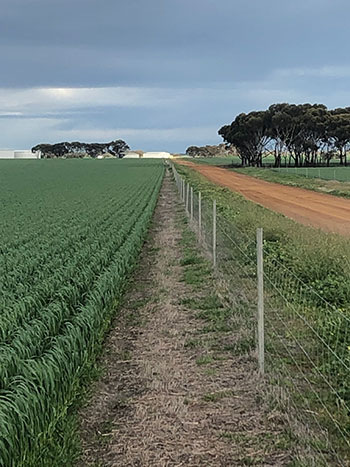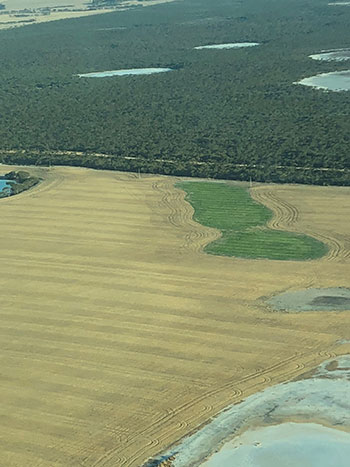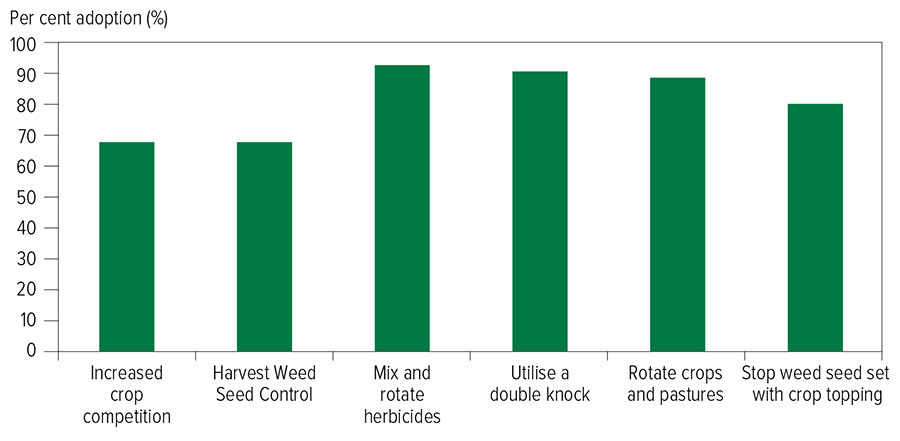Taking stock and updating management practices is vital for effective weed management – and industry events where information and experience is shared provide this opportunity.
Held in Esperance in August, WeedSmart week attracted 130 participants. WeedSmart project lead Jessica Strauss says the event attracted a large number of young growers this year, which was encouraging.
WeedSmart has investment from the GRDC and commercial companies and delivers science-backed weed control solutions. GRDC is a Platinum Partner in WeedSmart.
Customised whole-farm approach
One of those young growers participating in WeedSmart Week was Tom Longmire, who farms 5700 hectares with his parents Phil and Bindy on variable soil types at Beaumont, 110 kilometres east-north-east of Esperance in a 420 to 450 millimetre annual rainfall region.
“It’s a great opportunity to attend these industry events as you can learn from others. Everyone is dealing with the same issues but tackling them in different ways,” Tom says.
Tom is a third-generation farmer who returned to the family business in 2019 after completing a degree in farm management at Marcus Oldham College in Victoria. He was invited to share some of his family’s weed management experiences with the attendees.
“It’s an integrated whole-farm approach which keeps us on top of weeds, together with keeping a watch out for new tools,” Tom says.
“Probably the three key aspects of our approach are crop sequences, boundary fenceline management and amelioration, and management of hollows and salt scalds.”
The Longmires moved out of stock about 10 years ago and now have a five to six-year crop sequence – peas/wheat/canola/wheat/barley – which gives them an opportunity to vary their herbicide usage.
“Our problem winter weeds are wild oats, annual ryegrass and wild radish, while problem summer weeds include marshmallow, wild radish, portulaca and fleabane,” Tom says.
The crop sequence enables the Longmires to mix up not only herbicide types but timing of application, so they can preserve the use of chemicals on the property and reduce the risk of herbicide resistance. Figure 1 shows the sowing windows for the different crops, together with the variety and timing of herbicide application.
Figure 1: The diversity of crops used by the Longmire family to enable the use and timing of application of a range of herbicides. Sowing windows are indicated for each crop species.
 Source: Tom Longmire
Source: Tom Longmire
Sowing window selection is driven by two factors for the Longmires.
“In recent years with increased summer rainfall, dates have been brought forward slightly to access this moisture as growing season rainfall drops off,” Tom says.
But equally importantly, these sowing windows allow for some flexibility in the timing of clethodim applications.
“Our concern is too much selection pressure on annual ryegrass at set herbicide application timings. We need to maintain a large window of application across the germination phase to control this weed species and gain coverage on as many plants as possible. This is where our legume phase is important as it allows a mid-July spray timing and good access through the field pea canopy.”
The Longmires use a different weed management tool in areas of poorer soils and sodic clays, identified through electromagnetic mapping and yield maps.
“In these areas, we increase seeding rates and reduce fertiliser applications to increase crop competition, in particular to compete with wild radish and annual ryegrass. This is after seeing that crops in these regions were struggling to tiller.”
Fenceline management
On an eye-opening GRDC trip to South Australia’s Eyre Peninsula 10 years ago, Phil Longmire observed that boundary fencelines sprayed consistently with glyphosate harboured herbicide resistant annual ryegrass, which could then be spread by harvesters inward across paddocks. As a preventative measure, he introduced fenceline management on the farm.
 Two rows of crop are slashed around the Longmire boundary fences to enable unform and effective fenceline coverage of herbicides. Photo: Tom Longmire
Two rows of crop are slashed around the Longmire boundary fences to enable unform and effective fenceline coverage of herbicides. Photo: Tom Longmire
“We have boundary-mapped the farm and now slash the two outer rows of crop in early September, followed by a spray later in September with glyphosate to manage weeds,” Tom says.
“The external boundary has been mapped to 1.3 metres off the fence and we have bought a flail mower and tractor to match this width of management.”
This ensures that two rows of crop are slashed on all external boundaries. The reason for slashing before spraying is to delay the timing of boundary spray application and reduce the canopy. This allows for excellent weed coverage with herbicide. When smaller weeds are protected by leaf matter from older plants, there is a high risk that the weed won’t receive the recommended label rate and will be under-dosed, and, this encourages herbicide resistance development. Slashing helps reduce the risk of this occurring.
The Longmires then took a close look at internal boundary guidance, but they struggled to find a guidance system to implement steering on internal boundaries to prevent weed seeds being picked up from the edges during harvest and subsequently been spread across the paddock.
“We now have our sowing and harvesting operations on internal boundary guidance through John Deere so all machines don’t overlap and collect weed seeds over the boundary. This matches the exact boundaries that our individual nozzles on our sprayer are controlled by, so the only crop that has had herbicides applied to them is harvested.”
Salt scald management and amelioration of hollows
“The third key aspect to our weed management strategy is our salt scald management and amelioration of hollows – and how amelioration has been used to manage weeds after summer cropping,” Tom says.
 Salt scald sown to a summer crop mix of tillage radish and millet which is then mulched to increase the organic matter content of the soil. As the soil improves and weeds are controlled, the area is brought back into whole-of-paddock-production. Photo: Tom Longmire
Salt scald sown to a summer crop mix of tillage radish and millet which is then mulched to increase the organic matter content of the soil. As the soil improves and weeds are controlled, the area is brought back into whole-of-paddock-production. Photo: Tom Longmire
“Our salt scalds are the areas of the farm with the highest moisture due to poor crop production and lack of soil water depletion during the season. The management strategy that has been implemented on these areas has involved planting tillage radish and millet mix at 8.5 kg/ha and 3.5 kg/ha respectively in December and January to utilise the full moisture profile in these areas. The tillage radish has a higher salt tolerance for a germination and the millet germinates once a flushing rain is received.”
This operation has been in place for four seasons. One of the key factors was to ensure other operations are not inhibited by the summer crop. This has resulted in utilising individual nozzle control on the sprayers and accurate recording of summer crop mapping, so summer knockdowns on the rest of the paddock could still be done without the risk of spraying out these cropped areas.
The summer cropping program improved the soil conditions in the salt scald hollows, allowing the areas to be brought back into winter cropping production. However, it also encouraged improved germination of weeds from the existing seed bank. Especially around the edges where non-wetting sands accumulated. This presented another weed management challenge for the Longmires.
Hollow amelioration
The edges of the salt scald? hollows have a non-wetting layer from sand which has usually been blown from the bottom of the hollow and constituted two to six per cent of the whole paddock area.
There was an increased germination of weeds, such as wild radish, barley grass and brome grass, on the non-wetting edges. It was recommended to target these areas with herbicide application mixes to tackle these blow-outs. This complicated weed management, as it resulted in different spray timing and excessive use of selective herbicides that weren’t needed across the other 95 per cent of the paddock.
To manage these problem areas, a strategy was adopted to drag the non-wetting layer of sand back into the bottom of the hollow followed by clay-spreading the sand layer. The sand dragged into the hollow increases the profile depth and water holding capacity of these areas. The clay spreading and mixing of soil significantly improves the germination and productivity of crops sown into the hollow.
The improved germination of crops helps increase crop competition against weeds and standardised the weed profile across paddocks, making it much simpler and economical to manage.
“We can then manage the paddock as a more-uniform production unit,” Tom says.
Tom says the WeedSmart Big 6 provides an excellent framework to then customise a plan for your own business. Attending the WeedSmart week provided opportunities to learn about the new tools that he is continuously seeking.
Lessons learnt
- Consider a long-term, whole-of-farm strategy for weed management;
- Keep up to date with weed management techniques (both herbicidal and mechanical) to increase diversity and reduce resistance;
- Use a variety of crop species so you can rotate herbicide types and timing to reduce selection pressure on weeds;
- Accurate boundary mapping and accurate guidance in machinery is important to control weeds that may encroach on cropping areas;
- Use crops that are susceptible to salt such as legumes and canola for a true indication of how large the salt effect may be in cropping areas; and
- Look for precision methods of weed management over large production areas that have minimal chance of operator error.
More information: Tom Longmire, t.longmire@outlook.com, 0408 963 229; 149 Boundary mapping and soil amelioration changed the game for Esperance farming family
WeedSmart week takeaways
The three-day program for WeedSmart week consisted of a forum day and presentations at the Esperance Civic Centre, with two days of farm visits in the Esperance region to see how forward-thinking growers are implementing the WeedSmart Big 6 tactics to minimise the impact of herbicide resistance on their businesses.
Jessica Strauss says the targeted message for the event was about ‘the one per centers’.
“A no-tolerance approach to crop weeds delivers a mindset that ensures, at every
opportunity, weeds are being targeted. Aiming for 100 per cent control of weeds and diligently monitoring survivors will eventually result in a win against both winter and summer weeds,” she says.
Using this approach can reduce the weed burden, significantly reducing the risk of herbicide resistance occurring.
“As many herbicide rotations and herbicide mixes should be employed as possible, and always use full rates and mix different modes of action within the same herbicide mix in consecutive applications.
“Always use harvest weed seed control tools when it fits in the system, even when there appears to be very little weed infestation; it’s always about the one per centers.”
A survey of topical weed issues and “weeds of concern” was taken of attendees on the first day.
“An overwhelming majority of respondents (92 per cent) indicated that annual ryegrass is a problematic weed and a high priority of concern. Wild radish (60 per cent) and marshmallow (54 per cent) were identified as areas of concern for over half of the respondents. Brome grass (45 per cent), fleabane (43 per cent) and wild oats (28 per cent) were also considered problematic weeds by many respondents. Only five per cent of respondents said that portulaca is a problematic weed.”
“Summer growing annual ryegrass (48 per cent) and marshmallow (44 per cent) were considered the biggest concern for their business, followed by brome grass (40 per cent), fleabane (30 per cent), wild oats (22 per cent) and portulaca (11 per cent).”
When asked which of the WeedSmart Big 6 tools they had adopted over the past five years (Figure 2), 92 per cent said they had adopted ‘Mix and rotate herbicides’, 90 per cent ‘Utilise a double-knock’ and 88 per cent ‘Rotate crops and pastures’ tactics. The next-most-popular practice was to ‘Stop weed seed set with crop topping’ (79 per cent), followed by ‘Harvest weed seed control’ and ‘Increased crop competition’ (both 67 per cent).
Figure 2: What WeedSmart Big 6 tools have you adopted over the last five years?

Source: WeedSmart
When respondents were asked which WeedSmart Big 6 tools they are intending to implement to control weeds in the future, responses were again evenly spread across a number of tools. However, there was a more even spread across tactics with ‘Mix and rotate herbicides tactic’ coming on top but this time at 73 per cent, followed by ‘Different and diverse rotations’ and ‘Crop competition’ (66 per cent), ‘Harvest weed seed control’ (63 per cent), ‘Double knock’ (61 per cent) and ‘Crop top, hay, brown manure or long fallow’ (59 per cent).
When the attendees were asked which new weed control technology they were
interested in purchasing in the next five years and given several possible answers, the two most-popular technologies were ‘New pre-emergent herbicides’ and ‘Green-on-green/brown spray technology’ from 59 per cent of the respondents.
Forty seven per cent of respondents said they were interested in investing in a ‘Harvest seed impact mill’ and 34 per cent selected the ‘WeedSeeker/Weedit’ technology.
“The WeedSmart Big 6 is regularly updated to include the latest weed control technologies. We encourage everyone to use the Big 6 as a checklist for weed control and the WeedSmart platform for further information,” Ms Strauss says.
How to ask a WeedSmart question
Ask your questions about weed management in crops on the WeedSmart Innovations Facebook page WeedSmartAU or Twitter @WeedSmartAU
More information: WeedSmart Big 6; WeedSmart Week Esperance
Youth in Agriculture Group
Instrumental in boosting young growers’ attendance at WeedSmart week was the promotion of the event through the South East Premium Wheat GrowersAssociation (SEPWA)and its Youth in Agriculture Group (YAG).
Brett South, who farms with his parents-in-law Lyndon and Nikki Mickel at Beaumont, was active in establishing the SEPWA YAG in 2018.
“We saw an opportunity to start a young farmers’ group within SEPWA to not only provide a non-threatening learning environment but also a social group for the non-sporting,” Brett says.
The group have been very active in organising well-attended industry education events. In its first year, the YAG conducted a tour to Vietnam supported by SEPWA and the participants, in which a delegation followed their barley from the farm in Esperance to end product. They have since had a number of interstate trips to South Australia and Victoria to learn about different production systems.
“These opportunities can really help us get more informed and look at our own production systems through a new lens.”
COVID-19 has interrupted plans for further interstate and overseas trips for the time being, but Brett says there is much they can learn within Western Australia, planning trips to learn about input aspects of grain production, such as plant breeding.
He says the YAG also provides an important vehicle for capacity building and succession planning within SEPWA, as the younger generation can learn about aspects of running a grower group and trials under the mentorship of seasoned operators.
More information: Brett South, bretto.south@gmail.com, 0428 694 237.

























































